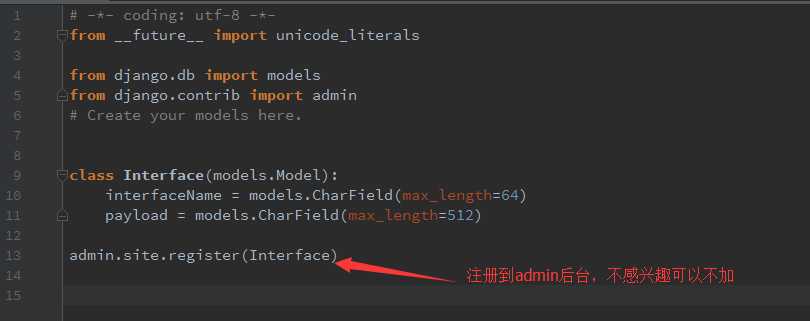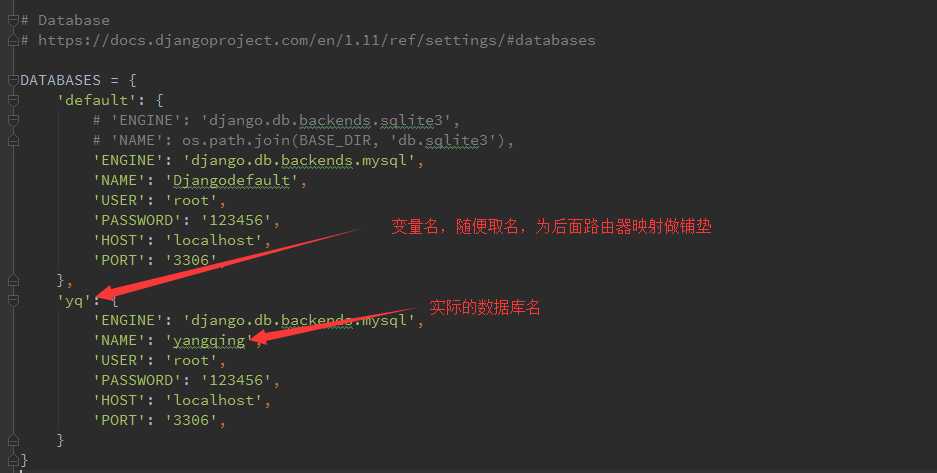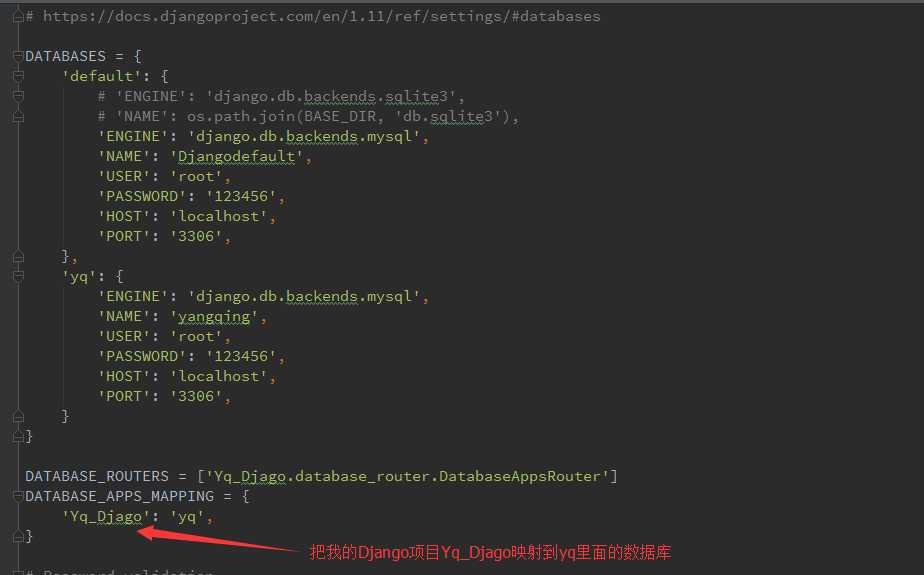标签:框架 配置使用 ima 其他 cdb pytho spec 正文 文件
今天来说说web框架Django怎么配置使用数据库,也就是传说中MVC(Model View Controller)中的M,Model(模型)。
简单介绍一下Django中的MVC:
模型(model):定义你的数据库,一般都在models.py文件中。
视图(view):定义你的HTML等静态网页文件相关,也就是那些html、css、js等前端的东西。
控制器(controller):定义你的业务逻辑相关,就是你的主要代码。
正文开始
首先要在你的Django项目中找到两个文件:setting.py、models.py
然后保证你的app要注册到setting里面哟

找到DATABASES处,该处就是配置数据库的地方,然后进行设置:
首先如果是才创建的项目,那么你的DATABASES应该是长这样的:

Django源生默认使用的自带数据库sqlite3。如果你要使用自带的,那你可以完全不用动这里的设置,如果你要使用其他的数据库,更改ENGINE的值即可,比如mysql:django.db.backends.mysql

当我们使用其他数据库时,必须对其他参数进行设置,不然Django可能连不上你指定的数据库,我这里拿mysql来举例

可以看到,多了一些参数,NAME就是你要使用的数据库名字(实现要创建好,不然Django找不到),USER就是数据库登陆账号,然后依次是密码,IP,端口。
到这里setting应该就算是配置完成了,接着打开models.py,进行编辑

最后通过CMD进入到你的Django目录,执行python manage.py makemigrations

再执行python manage.py migrate

成功ok!撒花
如果要进行多数据库配置,研究了一番,终于搞通了,确实要复杂一些。不过也不是很复杂,多了两三个步骤,下面我们一个一个步骤来
首先只需要在DATABASE下继续添加一个字典即可,例如我添加了一个yq,里面写清楚了我这个yq要引用的数据库

然后就是添加路由器DATABASE_ROUTERS和映射DATABASE_APPS_MAPPING

看到了DATABASE_ROUTERS = [‘Yq_Djago.database_router.DatabaseAppsRouter‘]吗,这个就是路由器的地址,意思是用Yq_Djago项目中的database_router文件里面的DatabaseAppsRouter方法
所以我们现在要去这个路径下创建一个database_router.py文件,然后进行如下编辑
from django.conf import settings DATABASE_MAPPING = settings.DATABASE_APPS_MAPPING class DatabaseAppsRouter(object): """ A router to control all database operations on models for different databases. In case an app is not set in settings.DATABASE_APPS_MAPPING, the router will fallback to the `default` database. Settings example: DATABASE_APPS_MAPPING = {‘app1‘: ‘db1‘, ‘app2‘: ‘db2‘} """ def db_for_read(self, model, **hints): """"Point all read operations to the specific database.""" if model._meta.app_label in DATABASE_MAPPING: return DATABASE_MAPPING[model._meta.app_label] return None def db_for_write(self, model, **hints): """Point all write operations to the specific database.""" if model._meta.app_label in DATABASE_MAPPING: return DATABASE_MAPPING[model._meta.app_label] return None def allow_relation(self, obj1, obj2, **hints): """Allow any relation between apps that use the same database.""" db_obj1 = DATABASE_MAPPING.get(obj1._meta.app_label) db_obj2 = DATABASE_MAPPING.get(obj2._meta.app_label) if db_obj1 and db_obj2: if db_obj1 == db_obj2: return True else: return False return None def allow_syncdb(self, db, model): """Make sure that apps only appear in the related database.""" if db in DATABASE_MAPPING.values(): return DATABASE_MAPPING.get(model._meta.app_label) == db elif model._meta.app_label in DATABASE_MAPPING: return False return None def allow_migrate(self, db, app_label, model=None, **hints): """ Make sure the auth app only appears in the ‘auth_db‘ database. """ if db in DATABASE_MAPPING.values(): return DATABASE_MAPPING.get(app_label) == db elif app_label in DATABASE_MAPPING: return False return None
最后再在models.py里面指定我们的表运用的是哪个数据,继续拿我自己写的例子举例

最后通过CMD进入到你的Django目录,执行python manage.py makemigrations

然后再创建数据库yq,执行python manage.py migrate --database=yq(不如不写--database就是默认创建default里面的)

打开数据库查看,大功告成!创建的interface和interface2两张表都在里面,撒花!!!

标签:框架 配置使用 ima 其他 cdb pytho spec 正文 文件
原文地址:http://www.cnblogs.com/semishigure/p/7509723.html